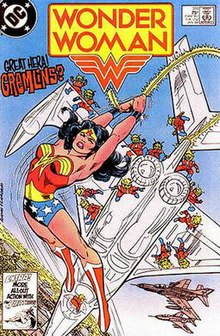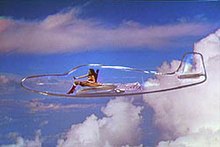Fictional vehicle used by Wonder Woman
The Invisible Plane (commonly known as the Invisible Jet) is a plane appearing in DC Comics, commonly used by Wonder Woman as a mode of transport. It was created by William Moulton Marston and first appeared in Sensation Comics #1 (January 1942).[1]
Original history
The Pre-Crisis version of the invisible plane was a necessity because before the Crisis on Infinite Earths rewrote Wonder Woman's history—along with the histories of many other heroes—Wonder Woman simply could not fly. She grew increasingly powerful through the Silver Age of comic books and beyond, acquiring the power to ride wind currents thus allowing her to imitate flight over short distance. This had limitations, however; for example, if there was no wind and the air was completely still she would be trapped on the ground or if dropped from a distance that she would helplessly fall out of control to the ground. Though this meant that she would rely on the invisible plane less frequently, she always had need of it.
The Invisible Plane was a creation of Diana's during her younger years on Paradise Island. She created it to be an improvement on her mother's planes which would be shot down in Man's World.[2] The result of her innovation was an invisible plane that could fly at terrific speeds silently and not be detected by hostile forces, thus avoiding unpleasant conflict. Initially, it was portrayed as being transparent.
The Invisible Plane appeared in the very first comic stories, including All-Star Comics #8, where it is shown as being able to fly at over 2000 miles per hour (MPH) and to send out rainbow rays that penetrate the mist around Paradise Island, as well as landing stealthily and having a built-in radio. Wonder Woman is seen storing the plane at an abandoned farm near Washington, D.C., in the barn; she goes there as Lt. Prince and changes clothes in some of the earliest tales. Though never explicitly stated, the Plane is presumably stored there when not in use for the rest of the Pre-Crisis era. In a story made shortly after, it flies at 40 miles a second.
Shortly thereafter, the telepathic capacities of Wonder Woman's tiara allow her to summon it, often to hover or swoop by the War Department, and she would exit on a rope ladder. She uses the plane to fly into outer space, and frequently transports Etta Candy and the Holliday Girls, Steve Trevor, or others. During the 1950s, the plane became a jet, and was often shown swooping over Lt. Prince's office; she stripped out of her uniform at super speed and would bound to the plane. Though the Plane was depicted as semi-transparent for the reader's convenience, in-story dialogue indicated that it actually was completely invisible, or at least able to become so as the need arose.[3]
Wonder Woman continued to use the plane for super-speed, outer space, and multi-dimensional transport up until the un-powered era of Diana Prince. When Wonder Woman resumed super-powered, costumed operations in 1973, she continued to use the jet as before, but did glide on air currents for short distances. At one point, Aphrodite granted the plane the power to fly faster than the speed of light for any interstellar voyages her champion might undertake.[4] Thanks to tinkering by gremlins, the Plane even developed intelligence and the power to talk.[5] The Plane proved a good friend, eager to help his "mistress" and her loved ones in any way possible. It got along especially well with Steve Trevor.
Later history
In the Post-Crisis version of the DC Universe, Wonder Woman can fly, regardless of wind currents, and so has little need for the Invisible Plane. The Plane's history has subsequently been revised as well.
The origin of the Modern Age version of the Invisible Jet was chronicled during John Byrne's run of Wonder Woman with more detailed information chronicled in Wonder Woman Secret Files #1.
The being that would one day be called the Invisible Plane began life as an alien "morphing crystal" circling a distant planet with its "family", other morphing crystals who are collectively called the Ring. In their natural state, the Plane and its fellow members of the Ring resemble eggs made of semi transparent plastic. In time, it was separated from its family and was found by the Lansinarians, a blind subterranean race that lived underneath Antarctica. The Lansinarians could not react quickly enough to changes in their environment. Thus, they developed the morphing crystal they had found into a life support device that catered to their needs. These beings later bestow the device on Wonder Woman in gratitude for saving them. The plane, which possesses a sophisticated artificial intelligence, responds to Wonder Woman's thoughts. It is able to render itself invisible as well as alter its shape, transforming into any form of vehicle its bearer desires, be it a jet, submarine, motorcycle, or horse-drawn chariot.
Wonder Woman, however, was initially unaware that her Invisible Plane was not only alive but was quite aware that it was being treated by its mistress as a lifeless tool.
Lacking her daughter's power to fly and taking her daughter's original Golden Age incarnation, Wonder Woman's mother, Hippolyta, makes good use of the Plane during her time-travelling stint as the Wonder Woman of the 1940s. To adjust to the era, she willed the device to assume the form of a prop-driven plane and it took on the appearance of the original invisible plane of the earlier comics. After its return to modern times, the Plane once again begins to display a personality, and like its earlier incarnation, it ultimately develops the power to talk. When a villain manipulates the Plane's feelings of anger at having been ignored for so many years regardless of faithful service, it attacks Wonder Woman and her friends. But after realizing what it had done, it displays its capacity for remorse after and tried to make amends by transforming itself into a floating base above Gateway City for its mistress. Proving a good—though mostly silent and faceless—friend, the Plane receives a proper name: WonderDome. Later, Dome's technology is also incorporated into the Amazons' city of Themyscira following its reconstruction in the wake of the Imperiex War. Dome even reunites with members of its long lost family at one point.
In Wonder Woman (vol. 2) #201 (by Greg Rucka), Dome sacrifices itself to prevent a tidal wave from killing thousands of innocent people. Having "died" to save so many, Dome is now more like a robot than a person. While it can still function in its traditional shape of an invisible plane, it can no longer alter its shape and is now a lifeless inanimate object that is neither intelligent nor self-aware.
Specifications
- Originally, the plane was supposed to be silent and move at supersonic speeds.
- It was created to attune itself to its user and its environment. The vessel responds appropriately and can take the form of any vehicle of earth, water and beyond (a submarine or rocket ship). As seen in its stint as WonderDome, it could even turn itself into a flying fortress.
- It has the power to be undetectable by radar or the human eye and the ability to shift from its crystal, "transparent mode" to complete invisibility rendering both itself and its occupants truly invisible, in true cloaking device technology form.
- The invisible jet propels itself by harnessing gravitation particles. It is in this fashion also that it shields its passengers from the forces of sudden acceleration.
- In outer space, the craft can extrude a portion of itself around Wonder Woman. Without taking in additional air supply, it can process one's own exhaled oxygen to allow breathing for 20 minutes. It can sense Wonder Woman's thoughts and will respond to her needs.
- Arsenal: The invisible jet can shape projectile weapons out of its own substance but doing so depletes the amount of material in the vessel. When such depletion occurs, the craft can regenerate itself slowly. This function is to be avoided and used only when absolutely necessary as a last resort.
- Although Wonder Woman possesses the power of flight, the invisible jet is very useful, as it contains certain on-board equipment, serves as a protective shelter, carries Wonder Woman's cargo, and, of course, renders her invisible for stealth missions.

